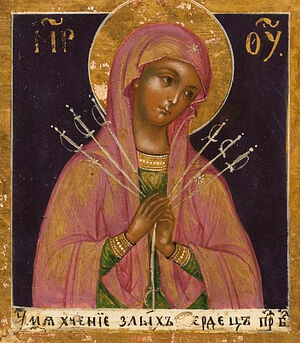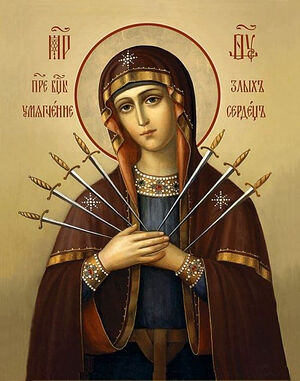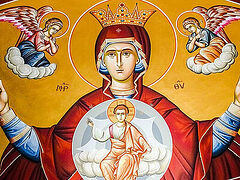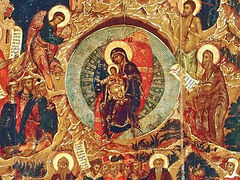 “Softener of evil hearts”… What a great deal of hope there is in the name of this icon: hope that someday justice will triumph on earth, that people will become kind and charitable, will begin to love one another. How difficult that is in our embittered world, and sometimes the mere sight of someone else’s suffering is enough to soften our own evil hearts...
“Softener of evil hearts”… What a great deal of hope there is in the name of this icon: hope that someday justice will triumph on earth, that people will become kind and charitable, will begin to love one another. How difficult that is in our embittered world, and sometimes the mere sight of someone else’s suffering is enough to soften our own evil hearts...
This Icon is also called the “Simon’s Prophecy” icon. According to the Evangelist Luke, the Holy Spirit told righteous Elder Symeon the God-receiver that he would not die until he had seen the Messiah. And thus, when forty days after the Divine Infant’s birth His parents brought Him to the Temple of Jerusalem, Symeon “was inspired” to come there as well, and took the Infant into his arms (hence the title “God-receiver”), and pronounced those famous words which ever since have been spoken at the conclusion of each Vesper service, and which are known as the Prayer of St. Symeon the God-receiver: “Now lettest Thou Thy servant to depart in peace, O Master, according to Thy word…” After that, he blessed St. Joseph and the Most-pure Mother of Our Lord, and addressed Mary with that same prophecy. It was after he had blessed St. Joseph and the Most-immaculate Mother of the Savior, that he addressed Mary with that same prophecy: “Behold, this child is set for the falling and rising again of many in Israel, and for a sin which shall be spoken against. Yea, a sword shall pierce through thy own soul also, that the thoughts of many hearts may be revealed.” Just as Christ would be pierced with nails and a spear, so the soul of the Most-pure One would be pierced by a certain weapon of sorrow and pain in the heart, when she saw her Son’s suffering. After that, the heretofore hidden thoughts of the people regarding the Messiah would be revealed, and they would face a choice: to be with Christ, or against Him. Such an interpretation of Symeon’s prophecy became the subject of a number of icons of the Theotokos. All those who turn to them in prayer sense that with the softening of evil hearts comes an easing of spiritual and physical suffering. People come to recognize that when they pray for their enemies before such icons, their feelings of enmity are softened, and that internecine strife and hatreds abate, giving way to kindness.
Evidently the “Softening of Evil Hearts” icon came from southwestern Rus’, but unfortunately there has never existed any supporting historical documentation of its origins. Even when and where it appeared is unknown. The Immaculate One is depicted on the “Softening of Evil Hearts” Icon with her heart pierced by seven swords—three on either side, or one below. In Sacred Scripture, the number seven usually indicates something’s fullness and abundance. In this case, it is the fullness of that boundless sorrow, pain and “sickness of the heart” experienced by the Theotokos during her earthly life. Sometimes, the Pre-eternal Infant is also depicted resting on her knees.
 Another Icon, the “Seven Swords” Icon is quite similar to the “Softening of Evil Hearts” Icon. They differ only in the arrangement of the swords: on the “Seven Swords” Icon, there are three swords on the right, and four on the left. It is commemorated on August 13, Old Calendar.
Another Icon, the “Seven Swords” Icon is quite similar to the “Softening of Evil Hearts” Icon. They differ only in the arrangement of the swords: on the “Seven Swords” Icon, there are three swords on the right, and four on the left. It is commemorated on August 13, Old Calendar.
During World War II, in the southern part of Voronezh Province, in a place known as Belogorye (“White Hill”—a reference to the chalk cliffs on the right bank of the Don near the town of Pavlovsk), there was a detachment of Italian mountain artillery men, allies of the Nazis. During the second half of December 1942, soldiers under the command of Lieutenant Giuseppe Pereigo found a “Softener of Evil Hearts” Icon in a bombed-out house. They gave it to their military chaplain, Fr. Policarpo, who was from Valdania. According to the locals, the Icon had come from the Belogorye Cave Monastery of the Resurrection near Pavlovsk. The Italians called the Icon the “La Madonna del Don,” the Madonna of the Don—not to be confused with the Donskoy Icon of the Mother of God. After the Ostrog-Rossoshansk campaign by Soviet forces in January 1943, the remnants of the decimated Italian contingent left Russia. Chaplain Policarpo took the “Madonna of the Don” with him to Italy, where in Mestra, a part of Venice, a chapel was built to house it. It remains a center of mass pilgrimages by friends and relatives of the Italian soldiers who perished in Russia.
Finally, there is another miraculous icon of the same type in the cathedral in the town of Zhizdra, near Bryansk, in southwestern Kaluga Province. It was known as the “Strastnaya” (i.e., Passion) Icon or, as it was described in the Cathedral inventory, the “And a sword shall pierce through thy soul also” Icon. It is also commemorated on August 13, the same day as the “Seven Swords” Icon and the far better known “Passion” Icon, which is of an entirely different appearance (the original miracle-working icon is in the Monastery of the Passion in Moscow. On it, near the “Hodigitria” image are two Angels and the implements of the Lord’s Passion—the Cross, the sponge, and the spear. Unlike in other “Passion” icons, in the Zhizdra Icon the Immaculate One is depicted in an attitude of prayer. With one hand she supports the Infant lying at her feet; with the other hand she guards her breast against the seven swords pointed toward it.




